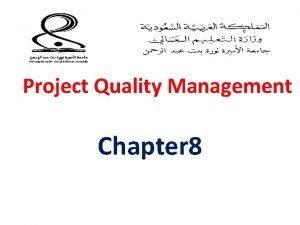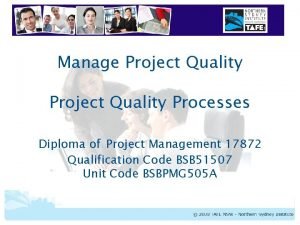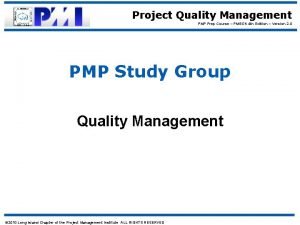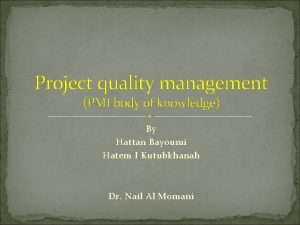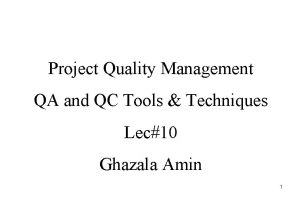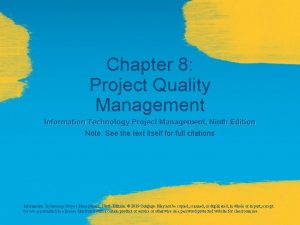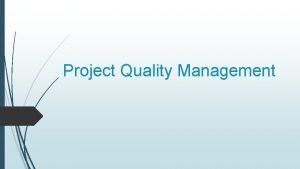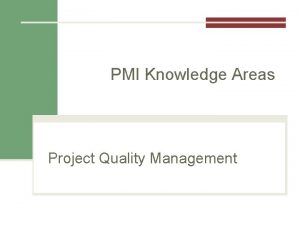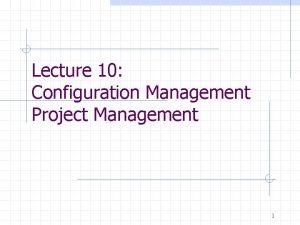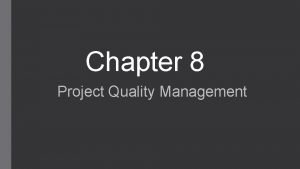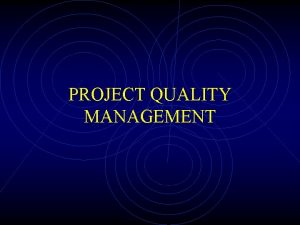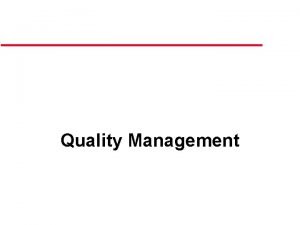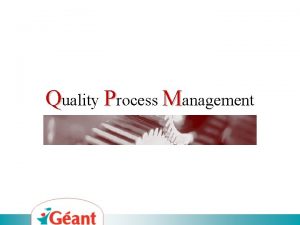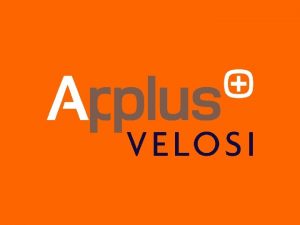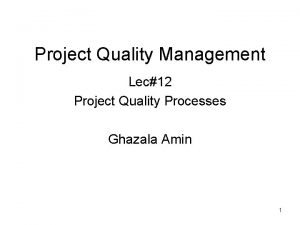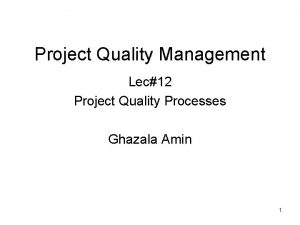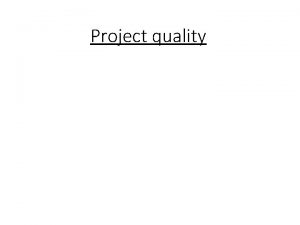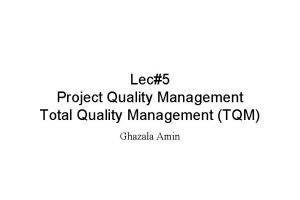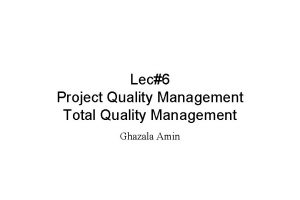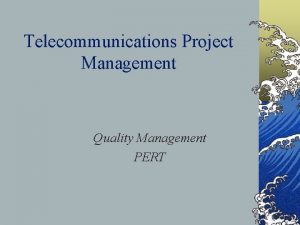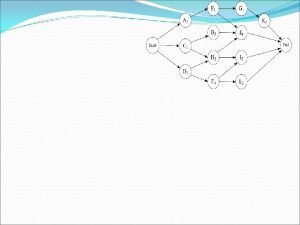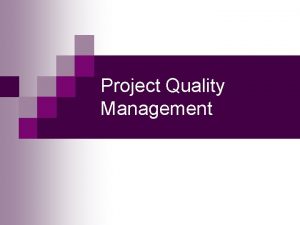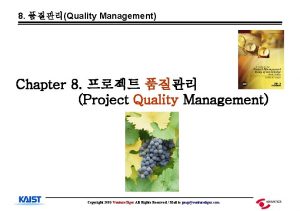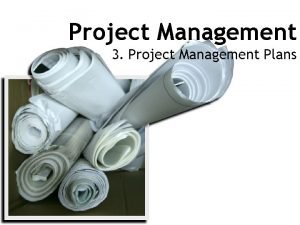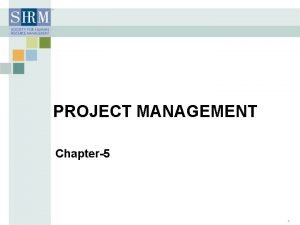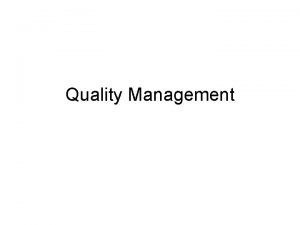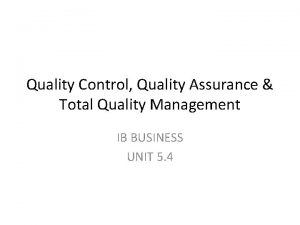Project Quality Management Project Quality Management 8 1

































- Slides: 33

Project Quality Management

Project Quality Management • 8. 1 Plan Quality • 8. 2 Perform Quality Assurance • 8. 3 Perform Quality Control

Quality Terms • Grade - Category or rank given to entities having the same functional use but different technical characteristics - Low QUALITY –ALWAYS a problem! - Low GRADE –may not be problem • Quality requirements - Determining the required quality grade - Determining the required quality level • Precision - Consistency that the value of repeated measurement are clustered • Accuracy • - Correctness that the measured value is very closed to the true value

Key Concepts • • Costumer satisfaction Prevention over inspection Quality is a management responsibility Quality is defined by the customer Quality is planned-in, not inspected-in Continuous improvement The cost of quality(COQ)

Key Concepts • Managerial Analysis - Optimal quality is reached at the point where the incremental revenue from improvement equals the incremental cost to secure it Continuous Improvement (Kaizen) - Small improvement in products or processes to reduce costs and ensure consistency of products or services TQM - Philosophy that encourage organization and people to find ways to continuously improve their business practices - Quality relates to all aspects of an organization

ISO 9000/9001 Series • A quality system standard applicable to any product, service, or process, in any industry • Consists of a three-part continuous cycle - Planning - Controlling - Documentation • Not a standard for products and services. • Not industry specific.

Quality Management in Projects • PMI’s approach on quality management is compatible with ISO Standards. • Project Manager’s has done ultimate responsibility for quality management on the project. • Gold Plating : – Giving the customer more than they requested- extra functionality, higher quality, better performance. – Implications is that you could have delivered what the customer expected faster and cheaper.

Project Quality Management • “… Includes the process and activities of the performing organization the determine quality policies objectives and responsibilities, so that the project will satisfy the needs for the which it was undertaken”*

Responsibility for Quality • Project manager has the ultimate responsibility for the product of project • Team members has responsibility to check his or her work(self-inspection) • Senior management has the ultimate responsibility for quality within the organization as a whole • Some costs of quality are too expensive for one project. Formal quality management must be implemented at an organization level.

Impact of Poor Quality • • Increased costs Low team moral Lower customer satisfaction Increased risk

8. 1 Plan Quality Inputs • Scope Baseline • Stakeholders Register • Cost performance baseline • Schedule Baseline • Risk Register • Enterprise environmental factors • Organizational process assets Process “…Identifying quality requirements and/or standards for the project and product, and documenting how the project will demonstrate compliance”. Tools & Techniques • Cost Benefit Analysis • Cost of quality (COQ) • Control Charts • Benchmarking • Design of Experiments • Statistical Sampling • Flowcharts • Proprietary quality management methodologies • Additional quality planning tools Outputs • Quality Management Plan • Quality metrics • Quality checklists • Process Improvements Plan • Project Document updates • Stakeholders register • Responsibility Assignment Matrix

Output- Quality Management Plan • Describe the system used by the Project management team to implement the quality policy on the project • Provides input to the integrated project plan • Based on the project scope and requirements • Purpose is to prevent the occurrence of defects and reduce the cost of quality • Must address quality assurance (QA), quality control (QC) and continuous process improvement

Other outputs • Quality Metrics - Detailed description of what will be measured and how • Quality Checklist - Tools are used to do verify that all required steps have been performed, usually component-specific. • Process improvement plan - Details the steps for analysing process to identify activities which enhance the value. - Process boundaries - Process configuration - Process Metrics - Targets for improves to performance

Quality Planning Tools • Cost benefit analysis - Considering benefits various the cost of satisfying quality requirement • Cost of quality - Looking at how the cost of quality will impact the overall project cost v Prevent phone cost v Appraisal cost v Failure cost

Cost of Quality Cost of Conformance Cost of Non Conformance Prevention Costs (Build a quality product) • Training • Documents Process • Equipments • Time to do it right Appraisal Costs (Assess the quality) • Testing • Destructive testing loss • Inspections Internal Failure Costs (Failures found by the project) • Rework • Scrap External Failure Costs (Failures found by the customer) • Liabilities • Warranty work • Lost business Money spent during the project to avoid failures Money spent during and after the project because of failures

Additional Quality Planning Tools • Control Charts – Used to determine whether a process is stable or has predictable performance – Covered in more detail in Perform Quality Control • Benchmarking – Looking at past projects to identify areas of improvement and to provide a measure of quality performance.

Additional Quality Planning Tools • Design of Experiments – Systematic use of experimentation to determine what variables will improve quality • Statistical sampling – Inspect by choosing only part of a population – When studying the entire population would take too long, measurement is destructive or too expensive. • Proprietary quality management methodology – Six sigma, CMMI, etc.

Additional Quality Planning Tools • Flow Charting – Graphical representation of how process flows from the beginning to end – Used in quality planning to anticipate quality problems that might occur. • Fishbone Diagram (Ishikawa) – Graphical tool that shows how various elements of system or process (causes) affect the result (effect)

Fishbone diagrams examples Machines Bad Tuning Material Incorrect Material Defects Material damaged MAJOR DEFECT Wrong Techniques Poor Skills Poor Planning Bad Attitude Personnel Process

8. 2 Perform Quality Assurance INPUTS üProject Management Plans üQuality Metrics üProcess Improvement Plan üWork Performance Information üQuality Control measurement PROCESS “Auditing the quality requirements and the results from quality control measurements to ensure appropriate quality standards and operational definitions are used TOOLS & TECHNIQUES • Plan Quality and Perform Quality Control tools and techniques • Quality audits • Process analysis OUTPUTS ØOrganizational process assets updates ØChange requests ØProject management plan updates • Quality management plan • Schedule management plan • Cost management ØProject document updates • Quality audit reports • Training plans • Process documentation

Quality Audits • A structured, planned review of quality management activities using the appropriate tools and techniques. • Ensure work is being performed to quality standards • Proactively offer assistance to improve implementation of process to assist team in raising productivity • The objective is to identify lessons learned for improving performance • May be performed by in-house auditors or by third party agencies.

8. 3 Perform Quality Management • • INPUTS Project management plan Quality matrices Quality checklist Work performance measurement Approved change request Deliverable Organizational process assets PROCESS “Monitoring & recording result of executing the qualities activities to assess performance & recommend necessary changes TOOLS & TECHENIQUE • Cause & effect diagram • Control chats • Flowcharting • Histogram • Pareto chat • Run chat • Scatter diagram • Statistical sampling OUTPUTS • Quality control measurement • Validated changes • Validated deliverable • Organization process assets updates § Complicated checklist § Lesson learned • Change request • Project management plan updates Quality management plan Process improvement plan

Deliverables • Quality management addresses - Products, services or result of the project - Project management deliverable

Quality Control Tools • Fishbone diagram - Cause and effect diagram (Ishikawa) • Control chats - Shows if a process is stable or has predictable performance • Flowcharting - Graphical representation of a process • Histograms - Bar chart showing a distribution of variables • Run chart - Examining history and pattern of a variation § Technical performance § Cost and schedule performance

Quality Control Tools • Pareto chart - Ordered by frequency of occurrence, Identify problem with the greatest impact • Statistical sampling • Scatter diagram - Show the relationship between two variables - Identify the possible relationship between changes observed • Inspection - Examination of a work product to determine whether it conform to standards • Approved change request review - Ensuring all changes request are reviewed and implemented as approved

Control chart Rules of Seven Specification Limit Out of Control Assignable Cause Control Limits

Pareto Chart

Flowchart 1 Project Request 2 Compliance Copy 3 Develop Artwork No 7 Vendors Make proofs 6 Artwork Out For proofs No 8 Package development Review/ Approval 5 Change Control for Specs. Yes No Yes 4 Artwork Approved 9 QA Review/ Approval 12 Order Materials Yes 10 Approved Proof Back to Vendor 11 Specs Signed (Package and QA)

Histogram • Depicts a distribution of cases that fall into categories • Height of each bar represents the frequency of occurrence • Provides an approximation of a data distribution

Run chart • Displays data points observed in a time sequence • Examines history and pattern of a variation - Technical performance - Cost and schedule performance • Facilities analyzing how quality trends over time

Scatter Diagram • Look for a pattern between the two variables. • Confirm that there is a relationship between two variables. • Linear patterns (i. e. points close to a diagonal line) indicate patterns.

Planning, Assurance & Control Quality Planning Quality Assurance Quality Control When is performed? Planning Executing Controlling Major concern Plan Implementing, Measure Overall check, Process correctness Typical questions • What quality standard should be used? • How will these standard be met? • How can the quality be improved? • Are the standards still relevant? • What is the number of errors? • What is the schedule performance? • Have we met the standards?

Question ?
 Introduction for project
Introduction for project What are quality standards in project management
What are quality standards in project management Project quality management definition
Project quality management definition Perform quality control
Perform quality control Project management lecture notes doc
Project management lecture notes doc Pmbok
Pmbok Pmi project quality management
Pmi project quality management Qcc tools and techniques
Qcc tools and techniques Plan quality management pmp
Plan quality management pmp Project management quality control
Project management quality control Project management quality control
Project management quality control Plan quality management tools and techniques
Plan quality management tools and techniques Importance of project quality management
Importance of project quality management Quality management in operations management
Quality management in operations management Contemporary issues in operations management ppt
Contemporary issues in operations management ppt What is tqm
What is tqm Quality assurance vs quality control
Quality assurance vs quality control Total quality management seminar
Total quality management seminar Compliance vs quality
Compliance vs quality Quality assurance vs quality control
Quality assurance vs quality control Quality gurus
Quality gurus Quality is free
Quality is free What is tqm
What is tqm The role of project management in achieving project success
The role of project management in achieving project success Modern process transitions in spm
Modern process transitions in spm When reducing project duration
When reducing project duration Modern project management began with what project
Modern project management began with what project Software project evaluation
Software project evaluation Types of project audit in project management
Types of project audit in project management Ms project agile planning
Ms project agile planning Varieties of project termination
Varieties of project termination Managing assets vs asset management
Managing assets vs asset management Configuration management system pmp
Configuration management system pmp Cost management principles
Cost management principles


